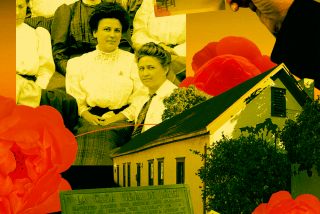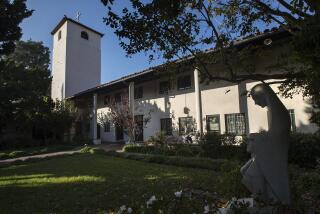Old Monastery’s Stones May Find Home at Last
- Share via
VINA, Calif. — They were chipped out of a quarry in Spain 800 years ago, prayed beside for centuries, appropriated by one of America’s most voracious collectors and then left for decades in San Francisco’s Golden Gate Park.
Now these rough-hewn pieces of a 12th century Cistercian monastery lie in old brandy barns here in the northern Central Valley, awaiting redemption.
Once destined for the swimming pool and bowling alley of a William Randolph Hearst estate, the limestone blocks from the Spanish Abbey of Santa Maria de Ovila are back among Cistercian monks.
The brothers want to reassemble them into a chapter house for their 1950s monastery, where they grow prunes and walnuts and host visitors seeking contemplative retreat. If they succeed, they will have on their grounds one of the few medieval structures reconstructed in this country.
The stones’ journey to the Abbey of New Clairvaux in this tiny farming community 115 miles north of Sacramento has been marked by financial extravagance, benign neglect, scholarly fascination and monkish tenacity.
It began in central Spain, where the Ovila abbey was founded in the late 1100s, one of hundreds of monasteries started in Western Europe by the reform-minded Cistercians.
For nearly 700 years, the Ovila monks followed a life of labor, silence and prayer amid the austere architecture for which their order was known. By the 1830s the number of brothers had dwindled to a handful. The abbey was closed and turned over to private hands.
The church, chapter house, cloisters and other monastery buildings fell from heavenly to the most earthly of uses--housing farm animals and equipment.
In 1931, Hearst was told of the decaying complex. A collector since childhood, the media baron was buying his way through Europe, stuffing warehouses with art, furnishings and even disassembled buildings.
At times criticized as a rich American raider of European treasures, Hearst saw himself instead as their rescuer.
He would use his acquisitions in the construction of his grandiose castle at San Simeon on the Central California coast and at Wyntoon, the estate near Mt. Shasta where he summered.
Hearst bought the entire monastery at Ovila for less than $100,000. He spent twice that amount to have most of the medieval complex dismantled, trucked to Valencia in crates and transported in 11 shiploads to San Francisco.
The stones--some of them weighing half a ton--were stored in San Francisco warehouses on their way to Wyntoon. There they were to rise as the walls of a swimming pool, bowling alley and entryway.
Before that could happen, the Depression rolled over Hearst. His financial problems forced him to relinquish control of his empire, dramatically scale back his spending and sell some of his collections.
In the early 1940s, after Hearst could find no buyers for the Ovila monastery, he gave its pieces to the city of San Francisco. In exchange, the city paid $25,000 in delinquent storage fees and agreed to rebuild the monastery as a museum.
The limestone blocks, some of them in crates, were trucked to a couple of spots in Golden Gate Park. Julia Morgan, the architect of San Simeon and portions of Wyntoon, drew up plans for the reconstruction, which was to be attached to the M.H. De Young Memorial Museum, named after Hearst’s old San Francisco newspaper rival.
But the plans went into storage and the stones stayed in the park, year after year. They were vandalized. Some were damaged in arson fires, some used by the city parks department to build walls and walkways around the arboretum.
In the 1980s, the De Young museum received two grants from the Hearst Foundation to study the possibility of reconstruction. Margaret Burke, an occasional museum volunteer who had a doctorate in medieval art history and a fascination with the stones, oversaw the projects and concluded that enough of one of the disassembled structures, the chapter house, existed to rebuild it.
Burke says De Young officials developed a reconstruction proposal. That too was never acted on.
Harry Parker, director of the Fine Arts Museums of San Francisco, concedes that the city’s record on the monastery project has been less than stellar over the decades.
“While it protected the stones to some degree . . . and encouraged Burke, [the museum] had failed to accomplish the basic task of reconstruction and had 50 years to do it,” he said.
So when Father Thomas Davis, the abbot at the Vina monastery, approached the museum about a rebuilding project in the early 1990s, Parker perked up.
“[Davis] was gung-ho and everybody said, ‘Maybe this is the best solution,’ ” Parker said.
Davis first laid eyes on the Ovila remnants in 1955. He had flown into San Francisco on his way to Vina to help open a new monastery on 600 acres that once belonged to Leland Stanford. During a drive through Golden Gate Park, a friend pointed out the heaps of stone.
They were from a Cistercian monastery and Davis was a Cistercian. He tucked the sight into his memory.
In the late 1970s, without a particular rebuilding project in mind, he asked for some of the stones. The parks department gave him about 20 blocks, which he hauled by pickup truck back to New Clairvaux. Most were returned when Burke undertook her reconstruction study.
But Davis didn’t forget them. He eventually struck an agreement with the museum. It would give the Ovila stones--roughly 1,300 of them at this point--to the Vina abbey on the condition that they be reconstructed within a decade of transfer and that the resulting building be open to the public.
In 1994 and 1995, 19 truckloads of the Spanish monastery arrived at New Clairvaux. The rebuilding project started to take tangible shape last year when a German immigrant from a long line of stone workers began to piece together blocks on the floor of a barn used for brandy-making during the Stanford era.
To put together the giant puzzle, mason Oskar Kempf is turning to Burke’s old drawings, photographs of the monastery before it was dismantled and three-dimensional computer renderings of how the stones might fit together.
With the help of a forklift and an assistant, he has so far matched up sections of several massive portal arches.
Occasionally Kempf discovers a mistake made by the Spanish stone workers--an off-kilter carving or a gap between blocks. He must decide whether to correct the errors or leave them be.
A Bay Area resident who came to the United States 16 years ago, Kempf contacted the abbey’s architect after reading about the stones in a weekly newspaper.
In an era in which Kempf laments the extent to which the “cheap and lousy” dominate, the chance to work on the Ovila project proved irresistible to him.
“This is my calling,” said Kempf, who has done restoration work for wealthy clients. “I believe whatever work you do--that is the real reason for self-respect.”
Chico architect Patrick Cole, who is overseeing the chapter house project, is equally passionate. He has traveled to Ovila, where he says the monastery ruins are now occupied by hay and chicken coops.
He admires the deliberate simplicity of Cistercian architecture and shivers at Hearst’s old plans. “I find it ironic that Hearst was going to use Cistercian stones to tout his own egotistical . . . whatever. They weren’t meant to be used for that.”
The Vina community of 23 cloistered monks hopes to incorporate the Ovila chapter house in a new abbey complex that, all told, will cost an estimated $13 million. Between $2 million and $3 million of that would go to the chapter house reconstruction.
“It’s ambitious,” said Father Paul Mark Schwan, who has spent the last 21 years at New Clairvaux, rising at 3:15 a.m. with the other monks for a day of prayer, silence and work in the orchards.
The abbey is applying for grants and has hired a professional fund-raiser. Those who have followed the stones’ long saga are hoping this project actually gets built. “I’m not sure who’s more eager that they succeed--they or us,” remarked museum director Parker, who will get the stones back, once again, if the monks fail.



